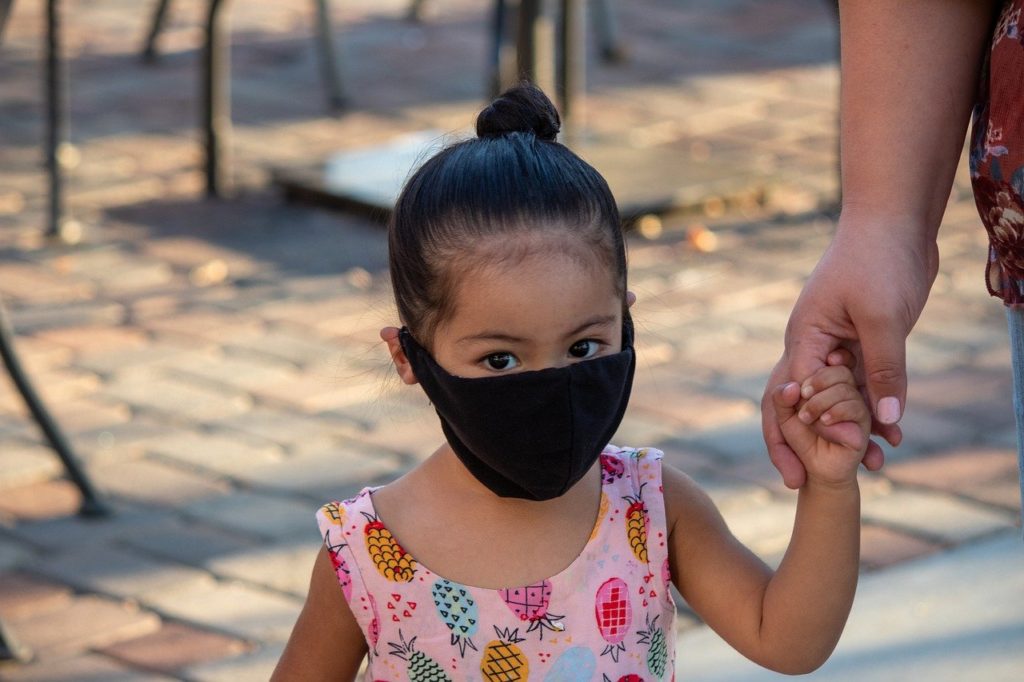
Children 2 years and older should wear a cloth face covering over their nose and mouth when in public settings where it’s difficult to practice social distancing. This is an additional public health measure people should take to reduce the spread of COVID-19 in addition to (not instead of) the other everyday preventive actions listed above. Leo Fontes/Pixabay
By CDC | July 28, 2020
Based on available evidence, children do not appear to be at higher risk for COVID-19 than adults. While some children and infants have been sick with COVID-19, adults make up most of the known cases to date.
Watch your child for any signs of COVID-19 illness
COVID-19 can look different in different people. People can get a fever, cough, or have a hard time taking deep breaths. Most people who have gotten COVID-19 have not gotten very sick. Only a small group of people who get it have had more serious problems.
CDC and partners are investigating cases of multisystem inflammatory syndrome in children (MIS-C) associated with COVID-19. Learn more about COVID-19 and multisystem inflammatory syndrome in children (MIS-C).
Take steps to protect children and others
Follow these everyday preventive actions and tips to help children stay healthy.
- Clean hands often using soap and water or alcohol-based hand sanitizer.
- Avoid people who are sick (coughing and sneezing).
- Put distance between your children and other people outside of your home. Keep children at least 6 feet from other people.
- Children 2 years and older should wear a cloth face covering over their nose and mouth when in public settings where it’s difficult to practice social distancing. This is an additional public health measure people should take to reduce the spread of COVID-19 in addition to (not instead of) the other everyday preventive actions listed above.
- Clean and disinfect high-touch surfaces daily in household common areas (like tables, hard-backed chairs, doorknobs, light switches, remotes, handles, desks, toilets, and sinks).
- Launder items including washable plush toys as needed. Follow the manufacturer’s instructions. If possible, launder items using the warmest appropriate water setting and dry items completely. Dirty laundry from an ill person can be washed with other people’s items.
- Make sure your children are up to date on well-child visits and immunizations.
You can find additional information on preventing COVID-19 at How to Protect Yourself and at Preventing COVID-19 Spread in Communities. Additional information on how COVID-19 is spread is available at How COVID-19 Spreads.
Limit in person playtime with other children, and connect virtually if possible
CDC recognizes this pandemic has been stressful to many and that socializing and interacting with peers can be a healthy way for children to cope with stress and connect with others. However, the key to slowing the spread of COVID-19 is to limit close contact as much as possible. It is important to understand potential risks and measures that you can take to protect yourself and your family.
An important guiding principle to remember is that the more people children interact with, and the longer that interaction, the higher the risk of COVID-19 spread. While children may be spending time with other people as they return to daycare or school settings, it is important to remember that exposure to additional children and adults outside of daycare or school should be managed to decrease risk.
For playdates, the risk of COVID-19 increases as follows:
Lowest risk: No in-person playdates. Children connect virtually (via phone calls and video chats).
Medium risk: Infrequent playdates with the same family or friend who is also practicing everyday preventive measures. Children maintain a distance of 6 feet from each other during the playdate. Playdates should be held outdoors, if possible. Indoor spaces are more risky than outdoor space where it might be harder to keep children apart and there is less ventilation.
Highest Risk: Frequent indoor playdates with multiple friends or families who are not practicing everyday preventive measures. Children do not maintain a distance of 6 feet from each other.
To help children maintain social connections while social distancing, help your children have supervised phone calls or video chats with their friends.
Clean hands often
Make sure children practice everyday preventive behaviors, such as washing their hands often with soap and water for at least 20 seconds. This is especially important if you have been in a public place.
Consider changing travel plans
Because travel increases your chances of getting infected and spreading COVID-19, staying home is the best way to protect yourself and others from getting sick. We don’t know if one type of travel is safer than others; however, airports, bus stations, train stations, and rest stops are all places travelers can be exposed to the virus in the air and on surfaces. These are also places where it can be hard to social distance (keep 6 feet apart from other people). Consult CDC’s travel considerations for more information on traveling in the United States.
Limit time with people at highest risk of severe illness from COVID-19
- If others in your home have an increased risk for severe illness from COVID-19, consider extra precautions to separate your child from those people.
- If you are unable to stay home with your child while school is out, carefully consider who might be best positioned to provide child care. If someone at higher risk for COVID-19 will be providing care (older adult, such as a grandparent or someone with a chronic medical condition), limit your children’s contact with other people.
- Consider postponing visits or trips to see older family members and grandparents. Connect virtually or by writing letters and sending via mail.
